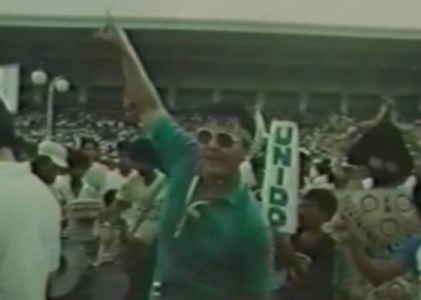We Are Colonial
This essay was originally written for the book Kidlat Tahimik, published by the Jeonju International Film Festival in 2011 for their Tahimik retrospective.
The Kidlat Tahimik retrospective at Anthology Film Archives in New York runs October 26–30. The Raya Martin retrospective at Museum of the Moving Image concludes October 27.
"How are we going to finish this film? We could just wait for the spaghetti to run out.”
To call Kidlat Tahimik’s Why is Yellow the Middle of Rainbow? (Bakit Dilaw Ang Kulay ng Bahaghari) (1994) the best Filipino film ever made is severely contentious. For one, Kidlat has remained an underground filmmaker throughout his entire career, in a country where the basis of significance is mirrored in the recall of a mass audience. Rather than an "other," he is understood as “that” person in the local arts world. The identity of Kidlat is similar to what his name alludes to: an impermanent flash of performances, mostly of himself dancing in only a G-string, an image of the national native that represents both pride and ridicule to the perception of arts in the Philippines. Everyone remains glued, in striking awe, to the show, but almost quickly dismisses and forgets.

Why is Yellow the Middle of Rainbow?
In the span of a decade, from 1981 to 1991, Kidlat put together a "celluloid collage" mostly inspired by and made with his eldest son and namesake, Kidlat de Guia, now a talented filmmaker in his own right. Alternatively known as I Am Furious Yellow, an early incarnation of this epic project, it transformed into a collection of other “colored” episodes, each corresponding to a progression of his life as a Filipino father. Finished in laboratories between New York and Manila, the film is a concise pronouncement of the Philippines' historical romanticized image as a colony of multiple masters.
The film is a showcase of artists: co-cameraman Boy Yniguez, best known as the cinematographer of Jeffrey Jeturian’s Kubrador (2006); the late Santiago Bose, one of the most important Filipino contemporary artists, whose collective works are representative of the post-colonial consciousness characteristic of artists from the mountain province of Baguio. Some footage was shot by Trinh T. Minh-ha, and there are cameos from the late Andrei Tarkovsky, on the way to the Telluride Film Festival in 1983, and even Kidlat’s close friend Werner Herzog. This is the world of Kidlat Tahimik.
That world is born out of a smaller bubble: Baguio, home to a wilder, label-resisting community where both the indigenous ease and artistic complexity harmoniously co-exist. This is where a naiveté is created. The isolation forces its inhabitants to embrace their city’s colonial origins as the American’s summer capital in the Philippines, with their camps scattered almost everywhere. The memory of childhood on this Disneyland of sorts is far removed from the usual Filipino's—celebrating Fourth of July as the real Independence Day, lining up for ice cream on the occasion. Kidlat, the father, is adamant about symbols in his household. Violence is taboo, and the kids are not allowed to play with guns. When they go through the newspaper to check out which movies to see, his son points to front-page images of the military’s war on rebels. That’s not a movie, he’s told.

Perfumed Nightmare
It’s all Hollywood, anyway. Even when Kidlat pieces home movies together with his more fictional footage and movie shots from elsewhere, there's a struggle against moviemaking as we are watching. We partake in the struggle to make sense of our identity determined by our screen image as a minority. We are celluloid existential, (re)visiting John Ford's Point on a snowy day while Hollywood music escalates our self-analysis. The journey is all euphemized, Filipinized. We are good Indians and we are better off dead.
The film could not be timelier. The political situation in it, spanning from right after the Marcoses’ overthrow to the late Corazon Aquino’s regime, to the attempted coup d’etat during her time, parallels that of the new presidency of her son, Benigno “Noynoy” Aquino III, and the reversal/return to power of the Marcoses with ex-first lady Imelda having been elected as congresswoman in her late husband’s province, as well as her two children, Senator Bong-Bong Marcos and Governor Imee Marcos. More disturbing parallels are the Philippine Nuclear Power Plant that had been erected and left directly on a fault line by the late dictator, and the recent earthquakes threatening the region; the celebration of new graduates from the Philippine Military Academy (where the best leaders emerge, as Kidlat’s mother points out), and the current investigations of military officials involved in corruption; the volcanic eruption of Mt. Pinatubo and the unforgettable earthquake in the early '90s that left most of the country’s economy crippled, and the recent devastating floods in Manila that highlighted controversies in the government’s distribution of relief funds. The Filipino reality becomes an endless litany of pleas, a curse that seems impossible to lift.
And yet Kidlat proposes “that,” coming directly from a nativistic proposal. Artists are moved to be like shamans in keeping touch with the old ways. In the bubble of it all, the artists are not constrained to museums or theaters. They exist where nature exists. Even when the absurd seems a contradiction, there is an unpronounced nationalism in the post-television aesthetic with which Kidlat presents the episodes of his film. It is told like any imaginary tale of the pre-colonial: from wondrous to disastrous, to tragic, and finally a rebirth. Until then, we are left to deal with the realities of our national mirage. It will be the same story decades later anyhow.
Why is Yellow the Middle of Rainbow? is a curious story of colors. One is reminded of a folktale for children written by Mexican Zapatista leader Subcomandante Marcos, La Historia de los Colores, inspired by his encounters with the Mayans, whom had tried to convince of a proletarian uprising. It tells the story of the origins of race, through a toucan, who narrates about the gods’ wishes to deliver more color to the world. Subcomandante Marcos was then left with another perspective on struggle and diversity. We are all cultural minorities fighting to protect our differences. History is determinedly human.
Why is Yellow the Middle of Rainbow?
Kidlat Tahimik’s cinema is best summarized by a scene in the film. Footage from his infamous unfinished-to-date Magellan project, an epic retelling of the explorer’s expedition to the Philippines, narrates: "Magellan taught his valet the rudiments of chess. Not only does he carve his own pieces and learns their movements, he picks up easily the thinking patterns of being a winner. The master realizes, for the first time, the slave is a thinking animal capable of plotting his own moves." "Checkmate," says Kidlat Tahimik, who acts as the indio slave in the film.
And as the whole film is a constant self-referential to Kidlat, the filmmaker, trying to make sense of his footage on the editing table, the celluloid on a flatbed spills all over a printed text by the Spanish scholar Antonio de Nebrija: Language is the perfect instrument of Empire.
"Is it any wonder that the indio now behaves like his master?"
The film ends twice. Kidlat’s son massages his father’s back, who has now fallen asleep while editing on the flatbed. The startled father rouses from his sleep, saying he had imagined making a film about his son, but the images had just taken over. An epilogue follows where a devastating earthquake has claimed the joyousness of Baguio, which was the hardest hit. The earthquake had destroyed the editing room, and in the dark the kids try to look for their father. They call out to him. Moments later, he appears from the celluloid rubble and enthusiastically says, I've found the ending.
Epilogue
After writing this essay, I go outside of my air-conditioned room. The housemaid is silently cleaning the corners of a house built from the marriage of my father’s activism and my mother’s corporate hard work. I smoke a pack of imported cigarettes in the garden, contemplating my tepid petty bourgeois existence. I notice the efforts of my father’s gardening, arising from his frustrations in farming. It is half-finished. Wild grass has taken over most of it, and he is in the computer room, “working” and practically retired to playing Farmville online. There seems so much work to be done, and yet...
It’s the age of disillusionment. The naiveté of Kidlat Tahimik has never resounded more profoundly.
Dedicated to Alexis Tioseco (1981-2009) ![]()
LATEST ARTICLES
-20140814-173707-thumb3.jpg)
Fighting Words
by Imogen Sara Smith
posted August 12, 2014

Fighting Words, Part 2
by Imogen Sara Smith
posted August 20, 2014

On the Margins: The Fil…
by Andrew Chan
posted August 12, 2014

Robin Williams: A Sense…
by David Schwartz
posted August 12, 2014
 We Are Colonial
We Are Colonial
THE AUTHOR
Raya Martin is a from Manila, Philippines. His films have screened at festivals around the world including Cannes, Locarno, and New York. He received his first U.S. retrospective at the Museum of the Moving Image in October 2012.
More articles by Raya Martin

